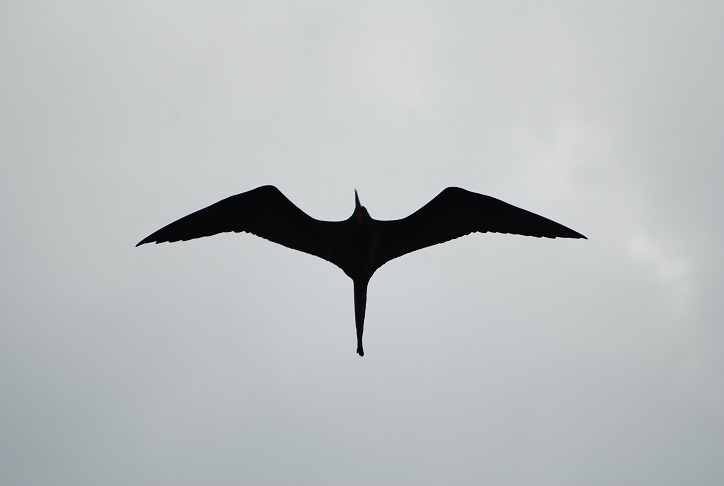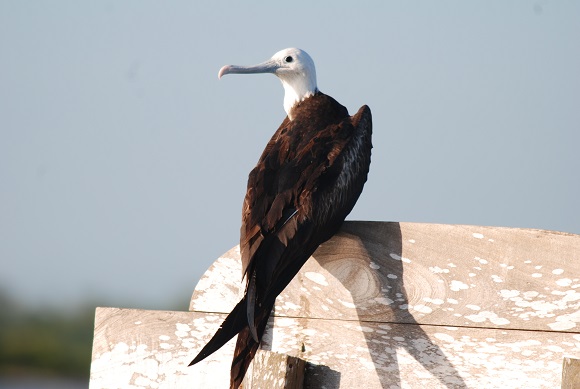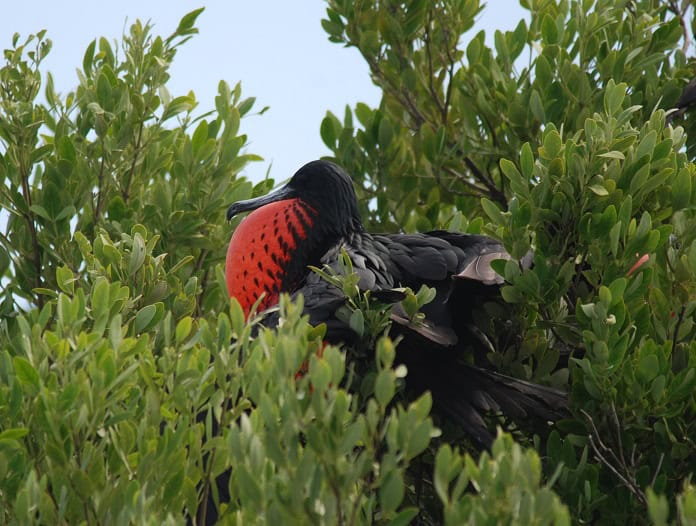
The Stealth Bomber of Birds

The Magnificent Frigatebird took me by surprise when I first saw one. It is huge and black, and the shape made me think of a stealth bomber aircraft. It has long wings with a bend in the middle and a long, forked tail. They are about 100 cm (39 inches) in length with a wingspan of 215 cm (85 inches).
They can be found along the coasts of Central America, southern Florida, the Caribbean Islands and northern South America. Sometimes they can be seen a bit further north along both coasts of the United States when it is not breeding season.

Frigatebirds are the only seabirds where the male and female birds look quite different. The males are all black. The females have white heads and breasts. Immature birds are similar to females but with more white extending down the front of the body.
Pirates
The Magnificent Frigatebird is a pirate. They attack other birds in mid-air and steal their food. Figatebirds eat mostly seafood such as fish, squid, crabs and offal. They find food on the surface of the water, which they pick up without landing. But mostly they attack other birds and force them to drop or disgorge their food, which the Frigatebird catches before it hits the water.
Although the Magnificent Frigatebird spends almost all of its time over the ocean, it does not land on the water. It would not be able to get up again. When it lands, it perches on a pole or other high object so that it can jump off and start flying before hitting the ground (or water). It spends several days at a time at sea without landing, always feeding on the wing.
Baby Frigatebirds and fledglings are cared for by their mother for about one year. The father abandons the family when the chicks are half grown. The males will mate the following year with a new partner. The females mate every second year.
They breed in colonies, mostly on small islands in the Caribbean. The males have a spectacular courtship display. To attract a mate, they inflate a bright-red sac on their throat, while clattering their bills, waving their head around and flapping their wings, all at the same time.
Isla Contoy National Park

To see the Magnificent Frigatebirds in their nesting colony and to see the males blowing up their throat sacs, I went to Isla Contoy, a small, uninhabited island off the southern coast of Mexico. You can see these birds anywhere along the coasts of southern Mexico but you will seldom see them perched and you will not see the males with their bright-red breeding sacs inflated unless you go to one of their breeding colonies. They seldom land except in their colonies. They can remain aloft for weeks at a time.
Isla Contoy is a National Park. There are boat tours starting from Isla Mujures. I suggest going in the largest boat you can find. It is one-hour trip over the open sea and if you go in a small boat you will get soaked by the spray. That is not to mention the roller-coaster ride over the waves. If you are prone to sea-sickness it will not be a fun day. Go with the larger boat, and ask to see the boat before you pay. Even in a larger boat it was not a fun trip but it is the only way to get to one of their breeding colonies.
After seeing the Frigatebirds, you can spend the a couple of nice hours on a beautiful sandy beach while waiting for the return ride. I was the only one on the trip that went to see the bird colony in the interior of the island; everyone else stayed on the beach. There are many nice beaches in Mexico and I did not think that for this purpose alone that it was worth the trip, but while you are there anyway it is a very nice place to rest and swim. Lunch in included with the price of the trip.
An Unforgettable Off-the-beaten Path Trip
Like many birds species, populations of Frigatebirds are declining due to destruction of their breeding habitat and other disturbances such as introduced animals on islands.
Once you have seen a Magnificent Frigatebird gliding overhead like a stealth bomber, it is something you will never forget.